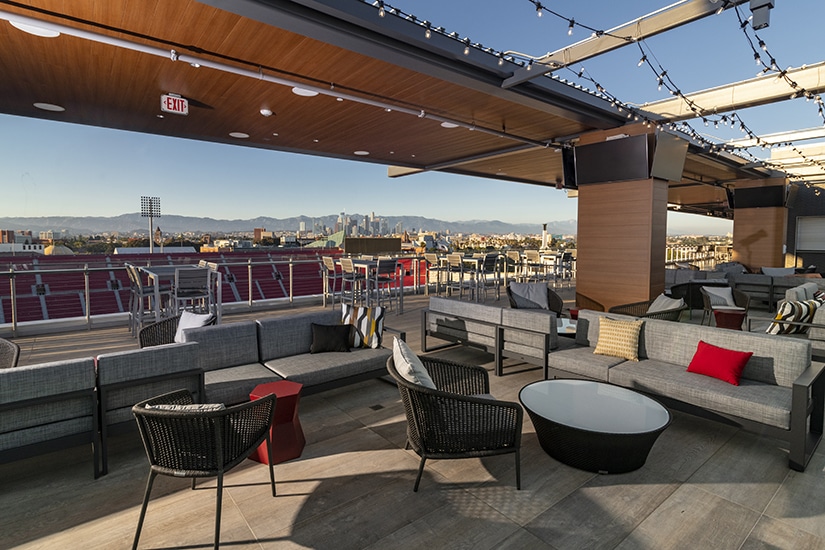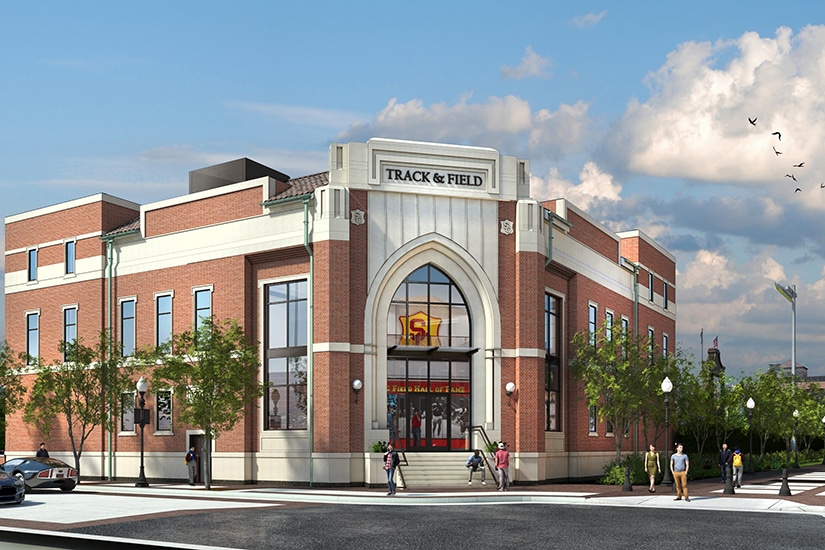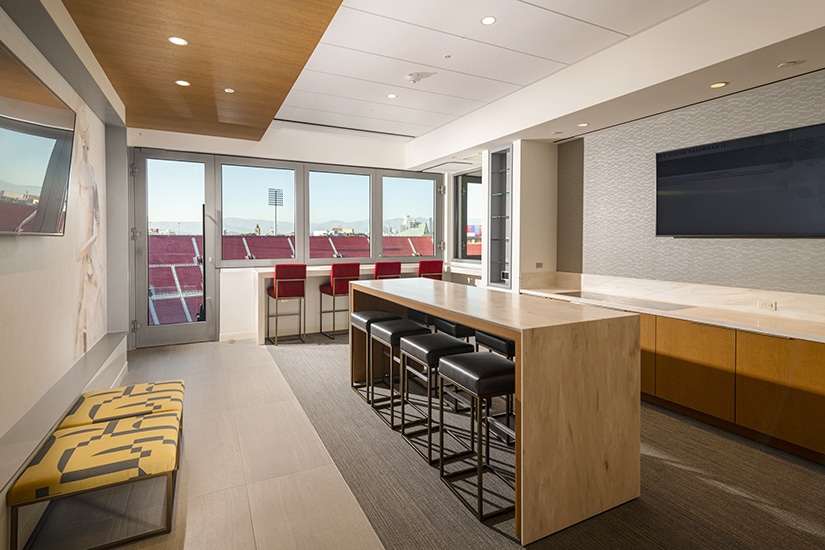|
Getting your Trinity Audio player ready...
|
The view from the upper deck end zone of the Los Angeles Memorial Coliseum—a visual sweep of the bowl’s thousands of cardinal-red stadium seats and the restored, Roman peristyle columns overlooking the opposite end zone—is impressive enough. But the sweep of history this storied stadium embodies is every bit as extraordinary.
The Coliseum, which opened in 1923 and received its third renovation between early 2018 and mid-2019, is on the US National Register of Historic Places. It has already hosted two Summer Olympics, in 1932 and 1984, and will be the first stadium to host a third in 2028. The entities claiming a strong connection to or “ownership” of the stadium are many, varied, and noteworthy.

None of this is lost on Jeff Fucci, associate athletic director for capital projects and innovation at the University of Southern California (USC), which holds a 98-year lease on the building (ownership is shared between the State of California, LA County, and City of LA and Coliseum Commission). Fucci has served at USC since 2009 in a series of ascending roles related to the university’s athletic program, and his work on a plethora of successful capital projects is celebrated by his external partners, such as Antunovich Associates, the esteemed national architecture firm working with USC the last four years to bring a major new track and field project forward on campus.
“We were thrilled to collaborate with Jeff on the design and construction of the new USC Track and Field Hall of Fame building and locker room facilities,” says Joseph M. Antunovich, the firm’s founder and president. “Jeff provided invaluable leadership, coordinating the efforts of the track and field coaches, the exhibit designers, architects, fundraisers, and the general contractor to keep the project on time and on budget. His commitment to ensuring that the design quality of the building was maintained throughout was honorable and a testament to his overall dedication and unbending commitment.”
These talents are perhaps what made Fucci such a strong fit for intimate involvement in the design and construction of the historic Coliseum renovation. “We had a duty to protect its status as a national historic landmark,” he affirms. “And we also needed to make it viable as a modern venue, with the amenities fans have come to expect. Further, we needed a building that could host events of varying sizes all year around.”

To be clear, the USC Trojans are synonymous with the Coliseum. Having played their first home football game in the Coliseum in 1923 (just five months after completion), the program has accomplished many historic feats, including 11 national championships, 37 conference
championships, and 34 bowl victories. The venue has always been celebrated as a sports and entrainment destination for the city, hosting NFL Football, Major League Baseball, international soccer, track and field, past and future Olympic games, and concerts for the ages (e.g., the Rolling Stones, Bruce Springsteen, the Who, and the Grateful Dead).
USC took on the Coliseum master lease in 2013, with the understanding that a renovation was required, the first such major overhaul of the facility since 1984. Over the years, a number of modest changes had taken place, including the addition of jumbotron screens that partially obscured the iconic peristyle feature, while original structural and aesthetic elements had eroded. The stadium’s utilities infrastructure had deteriorated, causing many areas of concrete to crack. Almost all electrical, plumbing, and even IT infrastructure had to be overhauled.
The beautiful new Scholarship Club Tower structure ties back to the building’s history, with exposed original board forming concrete and stadium raker beams in an open club space providing premium food and beverage options as well as private restrooms. Historical aspects like the paint in ancient Roman motifs under the peristyle arch were restored with stunning results. The peristyle was uncluttered and restored to celebrate its historic nature.

There are now 650 screens in concourses and club rooms away from field view, so fans never miss a moment while traveling to concession stands and restrooms. Amenities include universal Wi-Fi coverage, large LED TVs, and indoor video walls to keep them apprised of key away games. The newly constructed Scholarship Club Tower overlooking the field below will introduce even more attractions, special events, corporate events, and private parties on nongame days.
The $315 million renovation meant a complete replacement of seats in the bowl, handrails, and additional down aisles, providing more room for fans with improved accessibility, as total capacity reduced from 93,607 to 77,500 seats. Visitors will also find a beautiful 500-person rooftop terrace and 42 suites of varying size and amenity.
“The rip and replace of existing systems was a significant investment,” Fucci acknowledges. “But we had to employ digital technologies to minimize fan ‘friction points’ and enable a road map for an improved experience going forward, leveraging features available in modern NFL venues.”
Those friction points include a speedier digital ticket-access system utilizing near field communications (NFC). Stadium connectivity will even allow for mobile ordering and preordered food, reducing wait times at concessions. A point-of-sale system for all concessions helps the stadium move toward cashless transactions. And Wi-Fi capacity for handling tens of thousands of smartphones is now table stakes in stadiums. “This allows fans to fully utilize their smartphones to personalize their experience, utilize their apps, spend more time enjoying their game day and share this out with others socially.”

Given that the Summer 2028 Olympics aren’t too far away, the task of modernizing the stadium to meet current and future tech standards is particularly critical. The new converged network in the venue is scalable and can be refreshed in coming years as technology evolves A renovation project to support the future 5G implementation on the cell data side of connectivity laid the groundwork for this initiative. The venue took a giant leap forward to meet current venue technology standards while being mindful of future growth.
Fucci and the project team had several constituencies to satisfy in this renovation: the city, county, and state; the university; the historical conservancy; a Coliseum Commission; and of course—fans. The end result is triumphant. “This project brought so many disciplines together, working in partnership to deliver an outcome all could be proud of. There were so many dedicated and talented individuals involved in the project team. They deserve as much of the credit for the end result as anyone,” Fucci affirms. “The renovation helps restore the venue, making it viable for the next 100 years. It suits the LA stage.”


